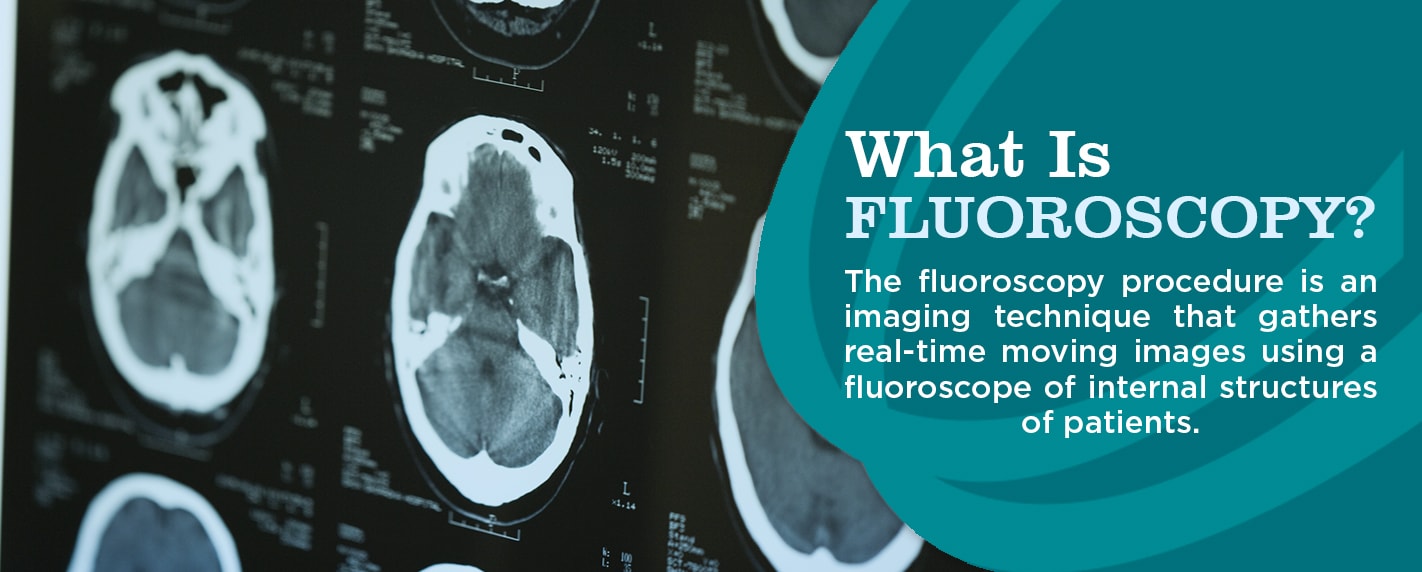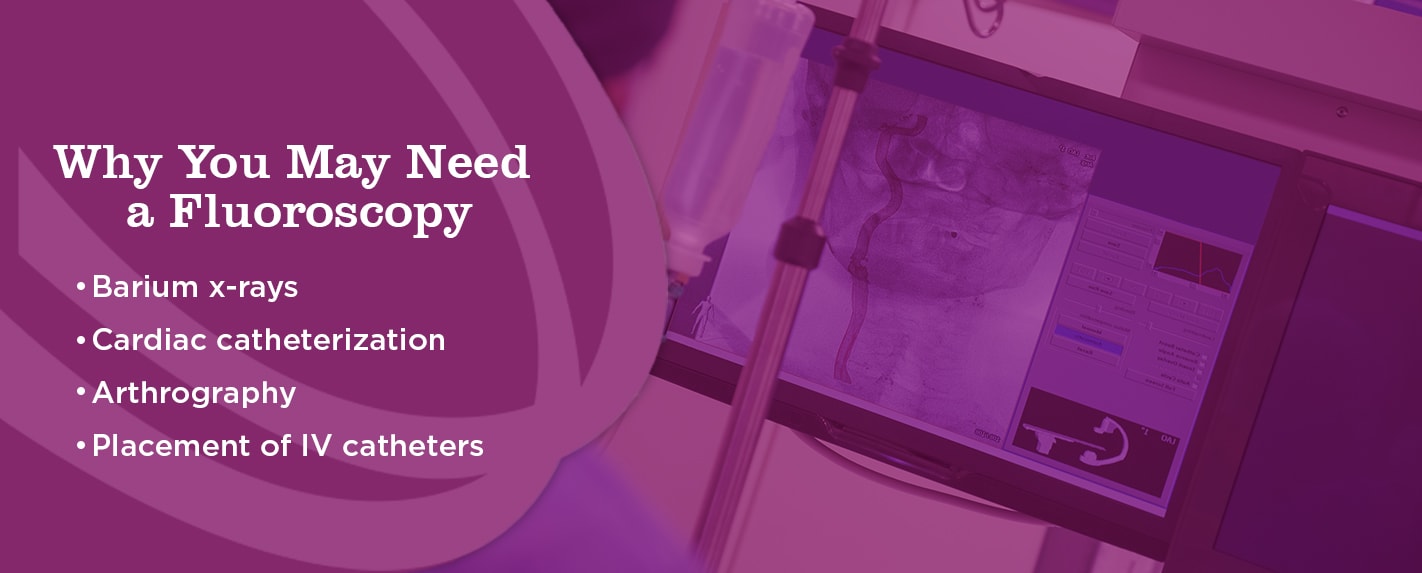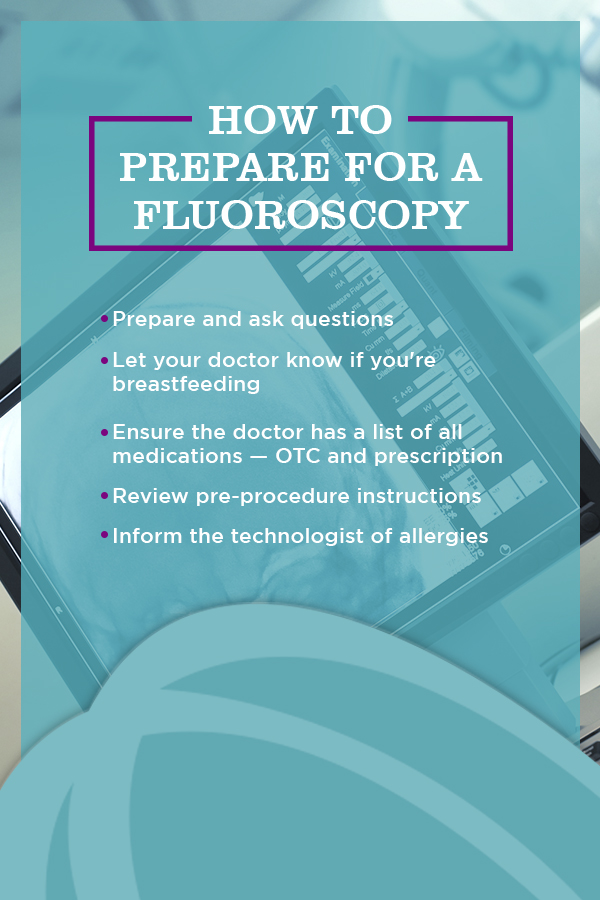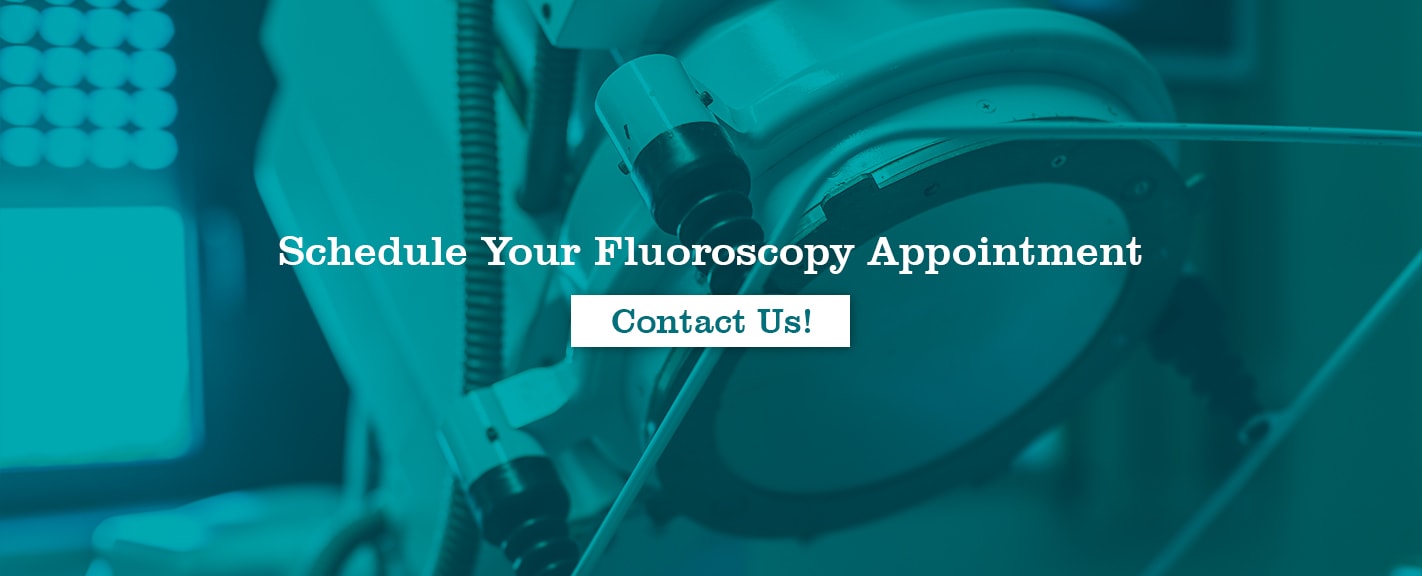What Is Fluoroscopy and How to Prepare
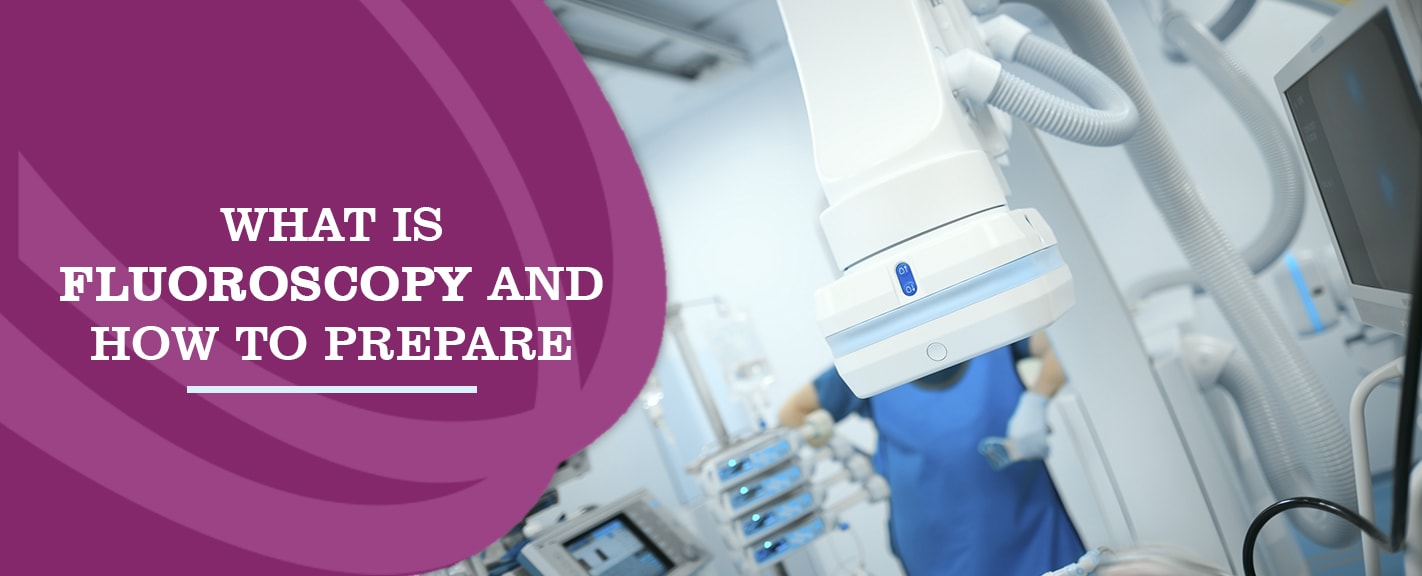
Your doctor has ordered a fluoroscopy procedure for you. Fluoroscopy can be a part of a procedure or exam performed on an inpatient or outpatient basis. You can schedule your outpatient fluoroscopy here at Envision Imaging, and our registered technologists, all of who have extensive training in radiologic procedures, help you feel comfortable and relaxed during your fluoroscopy.
Below you’ll find information about what fluoroscopy is and how to prepare for it. You’ll also learn what a fluoroscopy test detects and more.
Jump to Sections:
- What is Fluoroscopy
- Fluoroscopy Risks
- Fluoroscopy – How It Works
- Why You May Need a Fluoroscopy
- How to Prepare for a Fluoroscopy
- Schedule Your Fluoroscopy Appointment at Envision Imaging
What Is Fluoroscopy?
The fluoroscopy procedure is an imaging technique that gathers real-time moving images using a fluoroscope of internal structures of patients. A fluoroscope consists of a fluorescent screen and an x-ray beam passing through your body. It mimics an x-ray movie, where continuous images display on a monitor.
Fluoroscopy is extremely helpful to surgeons while they’re performing surgical procedures. It enables doctors to see moving structures of the body and helps with diagnosing diseases. Fluoroscopy offers enormous benefits over invasive surgical procedures since it requires a tiny incision, significantly reducing your risk of infection and recovery time.
A doctor can use fluoroscopy for any of the following reasons:
- Orthopedic surgery: Surgery concerned with musculoskeletal system conditions.
- Catheter insertion: Inserting a tube into the body.
- Blood flow studies: Visualizing the flow of blood to the organs.
- Enemas: Inserting a rubber tip into the rectum.
- Angiography: x-rays of lymph or blood vessels, including heart, leg and cerebral vessels.
- Urological surgery: Surgery of the urinary tract and sex organs.
- Pacemaker implantation: Implanting a small electronic device in the chest.
Schedule a Fluoroscopy at Envision Imaging
Fluoroscopy Risks
There are some minor risks associated with fluoroscopy. Because it uses x-ray technology, you have some radiation exposure. The amount you absorb varies depending on the procedure length and your size. Some individuals could experience radiation-induced injury to their skin that results in “burns” of their skin tissue.
Also, no matter what amount of radiation exposure you receive, there’s always the small risk of developing radiation-induced cancer down the road. When you require a fluoroscopic procedure, the advantages often far outweigh the risks.
While the fluoroscopy procedure isn’t painful in itself, some aspects of preparing for the test, such as accessing a vein or artery for angiography or injection into a joint, may be painful. In these situations, our Envision Imaging technologist takes possible measures to make you comfortable. These could include:
- Conscious sedation: Medications to make you sleepy.
- Local anesthesia: These are numbing medications.
- General anesthesia: Medications that put you to sleep, so you don’t feel pain.
You may have other risks depending on your health status. When performed by highly skilled, board-certified radiologic technologists, medically appropriate fluoroscopy examination benefits often outweigh the risks. Further, the Food and Drug Administration (FDA) regulates all fluoroscopy machines, and they must meet specific criteria to be considered effective and safe.
Fluoroscopy — How It Works
You may have a fluoroscopy exam performed on an outpatient basis at Envision Imaging, or you may need to stay in a hospital. The type of fluoroscopy you receive depends on your condition and your doctor’s recommendation.
Typically, fluoroscopy follows this process:
- You’ll likely need to remove any jewelry or clothing that could get in the way of the area of the body your doctor is examining.
- If you’re asked to remove your clothes, you’ll receive medical scrubs (top and pants) or a hospital gown to wear.
- The doctor may give you a contrast dye or substance, depending on which procedure you’re having done. The doctor may administer the contrast through an intravenous (IV) line, enema or have you swallow it. The doctor uses contrast so they can get a better look at your structures and organs they’re studying.
- The doctor or technician will position you on the x-ray table and depending on which procedure you’re having, they may ask you to move into various positions, hold your breath for a brief time or move a particular part of your body while they’re performing the fluoroscopy.
- If you’re receiving a procedure that requires a catheter, the doctor will insert a needle into your elbow, groin, heart or another site.
- The doctor or technician will use a special x-ray scanner to produce fluoroscopic images of the body structure they’re treating or examining.
- If the tech is observing a joint, they’ll remove any fluid in the joint with a syringe or needle before they inject the contrast dye. After they inject the contrast, they may ask you to move the joint for a couple of minutes to spread the contrast throughout your joint.
- The length of the examination is determined by the body part being examined and the type of procedure.
- After completion of the procedure, the technician removes the IV line.
- Your recovery time depends on the procedure. For instance, the recovery time for a cardiac catheterization could be several hours, while other procedures could be less.
Why You May Need a Fluoroscopy
You may require fluoroscopy for any one of many various procedures or examinations, including:
- Barium X-rays: Fluoroscopy is used in barium x-rays to allow the doctor to see the movement as the intestines move the barium through them.
- Electrophysiologic procedures: With an electrophysiologic procedure, the doctor uses fluoroscopy to treat patients with irregular heartbeats.
- Cardiac catheterization: In this procedure, the doctor uses fluoroscopy to help them see the blood flow through the coronary arteries, checking for arterial blockages.
- Arthrography: This is an x-ray to view one or more joints. Today, catheter arthrography is one of the major uses of chest fluoroscopy.
- Hysterosalpingogram: This procedure is an x-ray of the fallopian tubes and uterus.
- Placement of IV catheters: Catheters are hollow, thin tubes the doctor puts into your arteries or veins. When inserting the IV catheter, the doctor will use fluoroscopy to guide the catheter inside your body into a specific location.
- Percutaneous kyphoplasty/vertebroplasty: A doctor uses this procedure to treat spinal vertebrae fractures.
- Needle or transbronchial biopsies: A doctor uses this procedure to obtain a biopsy of tissue from a lung.
The doctor may use fluoroscopy by itself or along with another diagnostic procedure. There might be other reasons why your doctor would recommend fluoroscopy.
How to Prepare for a Fluoroscopy
Here are some of the fluoroscopy test preparation steps you may have to take:
General Preparation for a Fluoroscopy
Your doctor will first sit down with you and explain the details of the procedure, giving you a chance to ask any questions.
- Prepare and ask questions. Write down any questions or concerns you have so you can discuss them with your doctor before they perform the procedure. You may want to bring a trusted friend or family member with you to the preparation appointment to help you remember your concerns or questions and to take notes.
- Sign a consent form. You may need to sign a consent form giving the doctor permission to perform the procedure. Read the entire form carefully and if there’s something on it that’s not clear, ask about it. Ensure you understand everything before you sign.
- Let your doctor know if you’re breastfeeding. Ask if you need to pump your milk and save it to use after your procedure.
- Ensure the doctor has a list of all medications — over the counter and prescription. Also, let them know about any herbs, supplements or vitamins you’re currently taking.
- Review pre-procedure instructions. The specific type of exam or procedure performed determines if you’ll need to do any preparation beforehand. Your doctor will provide you with any pre-procedure instructions.
- Inform the technologist of allergies. Be sure you let your doctor, technologist or radiologist know if you’ve ever had a reaction to any contrast dye or if you’re allergic to iodine. Tell your doctor if you’re pregnant or think you might be.
Specific Fluoroscopy Preparation
Based on your health condition, your doctor might provide you with individual fluoroscopy exam preparation instructions you’ll need to follow before your procedure.
Many fluoroscopy and x-ray procedures like chest and bone x-rays require no preparation. The exceptions are fluoroscopy exams of the digestive system or kidneys, such as an upper GI series, upper GI with small bowel exam, barium enema, a kidney exam called an intravenous pyelogram or esophagram.
Commonly you will be asked to not eat or drink anything after midnight the night before your procedure. These tests require you to fast. Don’t take your routine morning medicines. Instead, bring them with so your doctor can inform you if you should wait to take them and, if so, when you can take them after your exam.
Other specific fluoroscopy preparation instructions according to type include:
1. Upper GI Series
Empty your stomach. Your upper GI tract and stomach must be empty for a satisfactory exam. Don’t smoke, eat or drink anything, including mints or gum after midnight the night before your exam. Bring a book, magazine or music player to your appointment to help pass the time. Bring any order your doctor provided to you.
Your doctor likely requested the upper GI series to assess frequent stomach pain or heartburn or if they suspect you have gastric reflux, which is when acid or food comes back up your esophagus, or an ulcer.
2. Upper GI With Small Bowel Exam
Empty your intestine and stomach for a satisfactory exam. It’s essential you don’t drink or eat anything after midnight the night before your exam. Don’t use mints, gum or cigarettes after midnight either. Bring any order your doctor gave you to your appointment. This procedure requires images on a timed basis to assess the small bowel. It is advised to bring a book, magazine, or music player with you.
The doctor is requesting images of your intestine and stomach with this exam to assess any issues not explained by a barium enema or upper GI test.
3. Barium Enema
You’ll need a 64-ounce bottle of sports drink, a bottle of Miralax and some Dulcolax tablets. Substitute a low sugar drink for the sports drink if you have diabetes. Don’t use carbonated drinks. Mix the Miralax with one of these beverages the day before your exam.
Don’t consume fibrous foods, such as fiber supplements or whole grain cereals, or raw vegetables or fruits for three days before your procedure. You can consume cooked and canned vegetables or fruits.
Drink only clear liquids the day before your procedure. Acceptable liquids include:
- Water
- Tea
- Clear broth or bouillon
- Clear juice like white grape, white cranberry or apple
- Sodas like club soda, seltzer water or ginger ale
Also on the day before your exam:
- Take two Dulcolax tabs at 1 p.m.
- Mix 119 grams or seven doses of Miralax in 32 ounces of the sports drink at 3 p.m. Drink eight ounces every 15 minutes.
- Take two Dulcolax tabs at 10 p.m.
Don’t eat or drink anything the day of your exam.
Your doctor requested this procedure to assess abdominal pain, a change in bowel habits, rectal bleeding, or if they suspect you could have polyps, which are abnormal tissue growths on your colon, or diverticulitis, which are small inflamed areas inside your colon.
The barium could make your stools a gray or white color for 48 to 72 hours after your procedure. In some cases, the barium can cause constipation. This could be temporary and can often be treated with increased fluids or an over the counter laxative.
4. Intravenous Pyelogram (IVP)
Don’t drink or eat anything for four hours before this procedure. Let the doctor know if you have allergies in general and an allergy to contrast dye or iodine. This injection does require contrast material containing iodine.
Your doctor requested this exam of your urinary tract, including your kidney, bladder and the tubes that connect them to show function and any pathologies.
5. Esophagram Exam
Empty your stomach four hours before your exam for a satisfactory test. Don’t use mints, gum or cigarettes after midnight the night before your exam. Bring any orders your doctor provided to you to your appointment. Bring along a book, magazine or music player.
Your doctor requested this exam to assess frequent heartburn, fluid or food in your windpipe, gastric reflux or difficulty drinking, eating or swallowing.
After your fluoroscopy, you can resume your regular diet and take your oral medications, unless the doctor instructs you not to.
Schedule Your Fluoroscopy Appointment at Envision Imaging
For more information on fluoroscopy or to schedule an appointment, contact Envision Imaging. We’re committed to making your diagnostic imaging experience as comfortable and relaxed as possible. We have a team of highly-trained, knowledgeable, innovative and caring healthcare professionals, including board-certified radiologists who will read your fluoroscopy results.
We deliver our services in elegant, comfortable and light-filled offices, and we’re always advancing our imaging technology. We have many advanced diagnostic imaging centers in Texas, Oklahoma, and Louisiana, so you can contact your nearest Envision Imaging center.
Besides fluoroscopy, Envision Imaging provides high-quality CT scans, MRI scans, mammograms and other medical services. We strive to offer you the best experience in diagnostic imaging services and to enhance your quality of life and health through our extensive educational information and services. Call us today to book your fluoroscopy appointment.
Sources:
- https://www.healthimages.com/services-flurorscopy.html
- https://www.envrad.com/services-flurorscopy.html
- http://www.montclairradiology.com/preparing-for-your-fluoroscopy
- https://healthcare.utah.edu/radiology/preparing-appointment/fluoroscopy.php
- https://www.medicalcenter.virginia.edu/imaging-outpatient/patient-information/fluoroscopy-pain-management-injections/fluoroscopy-prep.html
- https://www.sciencedirect.com/topics/medicine-and-dentistry/fluoroscopy
- https://www.hopkinsmedicine.org/healthlibrary/test_procedures/orthopaedic/fluoroscopy_procedure_92,p07662
- https://stanfordhealthcare.org/medical-tests/f/fluoroscopy/procedures.html
- https://www.urmc.rochester.edu/encyclopedia/content.aspx?contenttypeid=92&contentid=P07662
- http://radiology.ucla.edu/x-ray-fluoro-radiography
- https://www.hopkinsmedicine.org/healthlibrary/test_procedures/orthopaedic/fluoroscopy_procedure_92,p07662
- https://www.fda.gov/radiation-emittingproducts/radiationemittingproductsandprocedures/medicalimaging/medicalx-rays/ucm115354.htm
- https://www.cedars-sinai.edu/Patients/Programs-and-Services/Imaging-Center/For-Patients/Preparing-for-Your-Exam/X-ray-and-Fluoroscopy.aspx
- http://www.augustahealth.org/health-encyclopedia/media/file/health%20encyclopedia/patient%20education/Patient_Education_Fluoro.pdf
- http://www.montclairradiology.com/preparing-for-your-fluoroscopy


